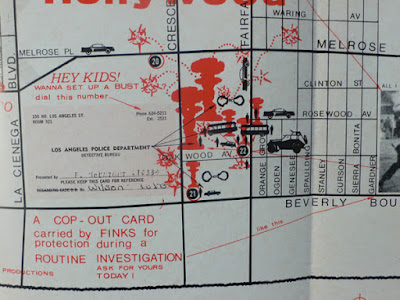I missed this earlier in the year but 2016 was the 50th anniversary of "Freak Out!" - the first album by Frank Zappa and the Mothers of Invention. Early pressings of the album contained a fake ad for a "Freak Out Hot Spots Map" for visitors to Los Angeles.
This map is an extremely rare collectors item and there are not many good images online. RecordMecca once had a copy, but it is listed as sold. Here's a more clear detail from their page.
It is a basic street map annotated with popular restaurants and clubs as well as areas of police activity or in Zappa's words:
This map is an extremely rare collectors item and there are not many good images online. RecordMecca once had a copy, but it is listed as sold. Here's a more clear detail from their page.
It is a basic street map annotated with popular restaurants and clubs as well as areas of police activity or in Zappa's words:
"where the heat has been busting frequently, with tips on safety in police terror situations."
"See the hapless trustees in their stenciled shirts washing HIS cars. Hear bold Aryan operatives rave about longhair freakos and the last John Birch meeting at 720 N. San Vincente Blvd"Other details include the Freak Sanctuary in Laurel Canyon, various numbered ghettos and the cultural desert-an area that roughly corresponds to the Mid-Wilshire neighborhood but may be meant to include the rest of the LA metro area. Also, those weird symbols that look like chess pieces to me are supposed to be atomic blasts and they represent busts by the LAPD. A full listing of the numbered locations on the map can be seen in the Frank Zappa Newspaper.


















































